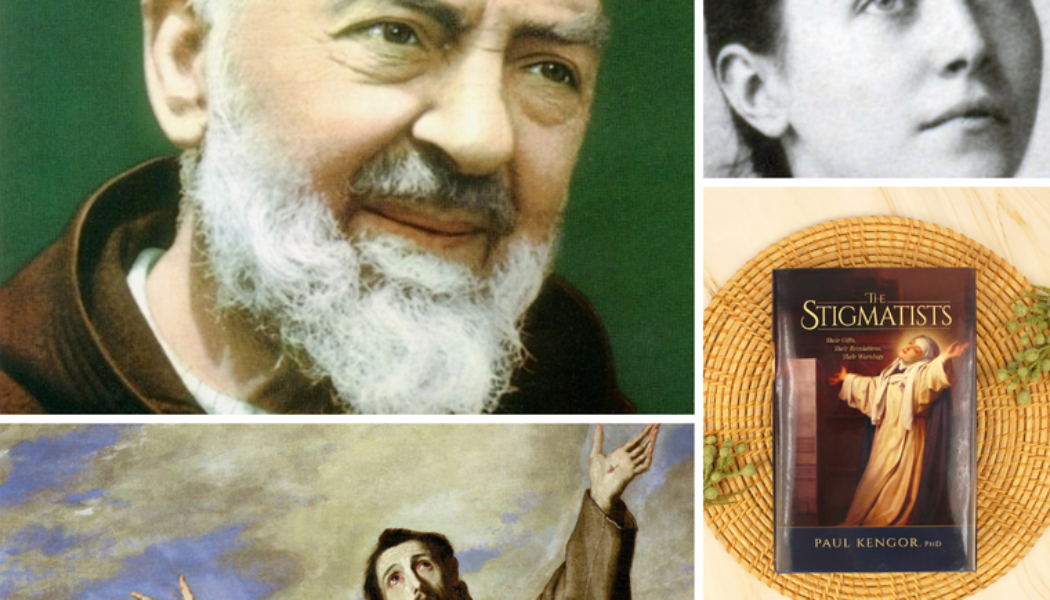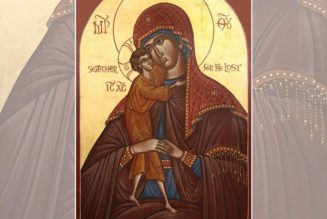
The date: Sept. 20, 1918.
The place: Our Lady of Grace Chapel, the church of the Capuchin friars at San Giovanni Rotondo, located in the Italian province of Foggia.
There alone in front of a crucifix of the suffering Christ was a suffering, humble, pious friar named Francesco Forgione (1887-1968), named after St. Francis of Assisi, another suffering, humble, pious friar — who in the year 1224 first bore the wounds of Christ; that is, the stigmata.
“After celebrating the Mass,” recalled Padre Pio, as he was later known, “I stayed in the choir for the due thanksgiving prayer, when suddenly I was overtaken by a powerful trembling, then calm followed, and I saw Our Lord in the posture of someone who is on a cross … lamenting the ingratitude of men, especially those consecrated to him and by him most favored.”
Jesus revealed his suffering and desire to unite souls with his passion. Said Pio, “He invited me to partake of his sorrows.”
The voice from the cross urged the young friar to work for the salvation of his brothers. The voice then told him, “I unite you with my passion.”
He would bear the markings, bleeding every day for 50 years and disappearing only shortly before his death on Sept. 23, 1968, at age 81.
What happened to Padre Pio was most certainly unusual and indisputably miraculous. It was not, however, unusual for a rare breed of blessed souls who we call stigmatists.
Stigmata are physical marks provided to the suffering soul as both a reflection and participation in the sacrificial passion of Jesus Christ. The marks are bleeding wounds, bestowed upon the so-called “victim soul” as a spiritual gift to singular individuals who seem distinctly willing to surrender themselves for the sins of others, as their Lord did at Calvary.
“The stigmatic represents the Crucified Christ to a world continually in need of a loving sacrifice that atones for our sin,” writes Deacon Albert Graham in his Compendium of the Miraculous. “The stigmata is not given to the stigmatic for his or her benefit but for the benefit of others.” The stigmatic becomes a sacrifice unto himself or herself, “transformed into a living crucifix who shares in the Lord’s Passion for the redemption of the world.”
There is debate over who was the first stigmatist in history. It is typically assumed that St. Francis was the first. He received the stigmata 800 years ago, on Sept. 17, 1224. But aside from Francis, the first stigmatist might well have been St. Paul. Note Paul’s words in Galatians 6:17: “I bear in my body the marks of the Lord Jesus.” We do not know, however, if Paul was referring to what we understand today as stigmata. He might have been speaking symbolically, noting that he suffered terribly, as Christ did.
From St. Paul to St. Francis is a long leap of more than 1,000 years. But since Francis in the 13th century, there have been several prominent stigmatists throughout history, who in every age astounded the faithful with their extraordinary Christian witness.
How many stigmatists have existed since the time of Christ? Truly, only God knows. To my knowledge, the Vatican itself maintains no running list. To have a definitive list of authentic stigmatists would be impossible in retrospect (numerous alleged cases in centuries past were never investigated) and would today require the Church to thoroughly investigate every claimed case. But we do have some data based on studies and a few books. I’ve attempted to arrive at some sort of general estimate. Perhaps the best we can say is that there seem to have been hundreds of cases since the time of St. Francis, probably about 400 to 500. Interestingly, though the two most famous cases are men, Francis and Padre Pio, the vast majority of stigmatists (nearly 90%) have been women. Nearly all have been Catholic. And among countries, Italy has produced far more than any other (about 70%).
We can also discern that stigmatists often share certain revealing traits, including:
Trial period. Among the stigmatists, there seems to be a period of trial and preparation by which the victim soul suffers physically and spiritually before receiving the marks. This might include hidden wounds at first. It can also include chilling attacks by demons and the devil, or even persecution by clergy who dismiss the stigmatists and accuse them of hypocrisy, fraud or worse. These trials seem almost like a test of their spiritual mettle, as if Christ is assessing whether they are ready to go still deeper.
Inedia. Inedia is the scientific term applied to persons able to live by eating little to almost nothing. (This is different from anorexia.) Several stigmatists have subsisted on virtually no food at all, except for the Eucharist. It becomes their daily Bread. In some cases, the stigmatist vomits up any other form of nourishment. Incredibly, some stigmatists have lived on nothing but the Eucharist for decades, such as St. Angela of Foligno (1248-1309), who was only recently canonized by Pope Francis.
Lack of sleep. Also curious among many stigmatists is their ability to subsist without much sleep. Padre Pio lived with very little sleep, often despite long, continuous, arduous hours hearing confessions.
Therese Neumann likewise carried on with little sleep, as did Sts. Catherine of Siena and Gemma Galgani. Amazingly, it is said that Catherine de’ Ricci slept for only about one hour each week.
Death at age 33. Among the most intriguing characteristics among several stigmatists, though in no way a majority, is the striking fact that several — virtually all women — died at age 33. Of course, that was also the age of Jesus Christ, whose wounds they bore, when he perished on the cross. Dying at age 33 were the likes of Catherine of Siena and Faustina Kowalska (1905-1938), as well as Louise Lateau (1850-1883), the Canadian-American Mary Rose Ferron (1902-1936) and Sister Josefa Menéndez (1890-1923).
Hidden stigmata. Some stigmatists endured invisible stigmata. Naturally, in our skeptical age, claims of hidden stigmata will incline many observers to doubt whether they really existed. Like Thomas at the side of the Risen Christ, we want to be able to see the wounds ourselves. Nonetheless, for whatever reason, certain suffering souls were given wounds that they alone could see and feel, perhaps to keep them humble and away from the sin of pride. Two prominent bearers of hidden stigmata were Catherine of Siena and Faustina Kowalska.
Incorruptibility. Several notable stigmatists exhibited an added rare physical phenomenon after their deaths: Their exhumed bodies were found to be incorrupt. That was the case for Frances of Rome, Lucy of Narni, Catherine de’ Ricci, Veronica Giuliani, Anna Maria Taigi and Padre Pio, among others. Their exhumed corpses — years, decades and sometimes centuries after their deaths — showed little to no sign of decay, often looking almost identical to their condition before they died.
Prophetic visions. Perhaps most intriguing is a common trait among stigmatists that prompted me to write the book: their gift of prophecy. It is quite revealing, and I would venture to say no coincidence — and above all something not to be ignored — that almost all Church-approved stigmatists have been visionaries as well as stigmatists.
So many stigmatists issued dire prophetic warnings, which they claimed were given to them by the likes of Christ himself, or often by his Blessed Mother. These have included visions of three days of darkness or a final-days fire from the sky that will chastise humanity’s sins, purify the earth once again, and initiate the End Times and Second Coming.
Among them, ponder the example of the Polish nun St. Faustina, the first canonized saint of our new millennium. Of all the stigmatists that I profiled, I believe that her visions carry a special weight for our day. She recorded these visions in detail in her published diary.
Faustina wrote in her diary in May 1935 that Jesus told her, “You will prepare the world for My final coming” (429).
In December 1936, Faustina reported that Jesus Christ told her: “Speak to the world about My mercy; let all mankind recognize My unfathomable mercy. It is a sign for the end times” (848). Two months later, in February 1937, the Polish nun further said that Jesus told her: “Secretary of My mercy, write, tell souls about this great mercy of Mine, because the awful day, the day of My justice, is near” (965).
Is the hour that Faustina so often wrote about now near? Is it upon us today in our time? Faustina Kowalska was not the only stigmatist who bore such signs and messages. Several others from the last century issued similar dramatic, prophetic warnings with the spiritual takeaway: Seek God’s mercy now and at all times.
Among their visions and messages and truly incredible lives, these stigmatists urged nothing less. They had much to tell us and to show us, especially with their divine markings. But above all, they wanted to show us a divine glimpse of heaven and to be prepared to get there.
Paul Kengor is editor of The American Spectator and a longtime professor of political science at Grove City College. He is the author of more than 20 books, including The Stigmatists: Their Gifts, Their Revelations, Their Warnings (TAN Books, September 2024).









